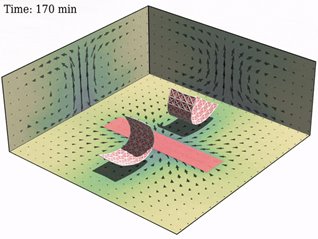Engineers Learn the Secret of Syncing
Engineers Learn the Secret of Syncing


How can you drive purely synthetic objects to sync up like croaking tree frogs? Photo: Getty Images
There’s a rhythm to life that almost every living and non-living thing can tap into. Many species of schooling fish will swim in unison, birds will fly in intricate patterns called murmurations, humans will synchronize their clapping after a performance, even two clocks on the same wall will begin to tick in tandem. This rhythm is the driving force behind a new discovery from a team of engineers at the University of Pittsburgh.
In addition to schooling fish and bird murmurations, the team also researched the Japanese tree frog, which croaks in accordance to other frogs in the same area – indicating not only a spatial awareness but an internal time clock. On top of this, they also coordinate their bodily movements, changing shape to produce their loud calls. This coordination of movement, oscillation, and morphological functions inspired the team to explore a new method for soft robots that can do the same.
“Our question was, ‘how can you drive purely synthetic objects to sync up much like you would see synchronization in biology?’” said Anna C. Balazs, Distinguished Professor of Chemical and Petroleum Engineering at the John A. Swanson Chair of Engineering. “One object has to clearly send a signal to the other object and the other object has to recognize that signal as real input, and then react on that signal, which is then sent back to the first object so that they can effectively communicate.”
As Balazs explains, making these kinds of synthetic communicating materials is very challenging. Her colleagues Raj Kumar Manna, who led the study, and co-author Oleg E. Shklyaev, both postdoctoral associates, began their quest by placing micron-sized flexible sheets into a fluid-filled chamber. The sheets are coated in a particular catalyst, which causes a chemical reaction in the chamber. This reaction generates a fluid flow that causes the sheet to move in different shapes. The movement from the sheet is then converted into chemical energy that pushes back on the chamber, creating a feedback loop. When a second sheet is added to the chamber, both of the sheets begin to synchronize their movements, resembling fishtails as they spin around in unison.
“There are underlying principles at play, which cause the system to resemble the basic social behavior of the frogs,” Shklyaev said. “It is a spectacular demonstration of biology, even though it is not biology at all.”
What’s particularly exciting about the reaction between the sheets and the fluid is the continuous feedback. There are no external drivers that cause the sheets to move in this way, so it’s a completely self-contained unit. This means that when applied to robotic technology, the individual robots will not require any mechanism to communicate and coordinate their movements, just like the small sheets inside the chamber.
Engineers are very interested in “swarmalator” technology – the combination of swarming/coordination and oscillation – for specific applications like mining, construction, search and rescue, and more. Most current swarmalators use complex and bulky sensors or GPS to coordinate with one another. This also means that the robots have to be programmed to sync up. But, as Balazs explains, with this chemically-powered innovation, robots won’t need an external signal to communicate or coordinate.
“We can now start thinking about levels of communication between machines that don't need as much instruction,” Balazs said. “After you apply the chemical, you could walk away and the robots will operate autonomously.”
The team is currently running a number of scaling analyses on the sheets, measuring the speed and velocity of their movements as additional sheets are added or sheets of varying sizes. Calculating these analyses so that they can be applied to larger forms of technology will take some time. But, the team is eager to get to that point.
Their next endeavor is to explore what happens when several sheets are added to the chamber. Manna explains that when multiple sheets are added to the chamber, they begin to move in a helical pattern, weaving in and out.
“Raj cooked up a scenario where the sheets started to come together and began rotating like ribbons,” Balazs said. “This naturally led us to pursue self-weaving. Think how cool it would be if you had a fabric that made itself.”
The team will continue to run simulations in hopes that they can find more real-world applications for the bio-inspired computation process. In the meantime, watching the sheets dance in unison is reason enough for the engineering community to be excited.
Cassie Kelly is a technology writer based in Groveport, Ohio.
In addition to schooling fish and bird murmurations, the team also researched the Japanese tree frog, which croaks in accordance to other frogs in the same area – indicating not only a spatial awareness but an internal time clock. On top of this, they also coordinate their bodily movements, changing shape to produce their loud calls. This coordination of movement, oscillation, and morphological functions inspired the team to explore a new method for soft robots that can do the same.
“Our question was, ‘how can you drive purely synthetic objects to sync up much like you would see synchronization in biology?’” said Anna C. Balazs, Distinguished Professor of Chemical and Petroleum Engineering at the John A. Swanson Chair of Engineering. “One object has to clearly send a signal to the other object and the other object has to recognize that signal as real input, and then react on that signal, which is then sent back to the first object so that they can effectively communicate.”
As Balazs explains, making these kinds of synthetic communicating materials is very challenging. Her colleagues Raj Kumar Manna, who led the study, and co-author Oleg E. Shklyaev, both postdoctoral associates, began their quest by placing micron-sized flexible sheets into a fluid-filled chamber. The sheets are coated in a particular catalyst, which causes a chemical reaction in the chamber. This reaction generates a fluid flow that causes the sheet to move in different shapes. The movement from the sheet is then converted into chemical energy that pushes back on the chamber, creating a feedback loop. When a second sheet is added to the chamber, both of the sheets begin to synchronize their movements, resembling fishtails as they spin around in unison.
“There are underlying principles at play, which cause the system to resemble the basic social behavior of the frogs,” Shklyaev said. “It is a spectacular demonstration of biology, even though it is not biology at all.”
What’s particularly exciting about the reaction between the sheets and the fluid is the continuous feedback. There are no external drivers that cause the sheets to move in this way, so it’s a completely self-contained unit. This means that when applied to robotic technology, the individual robots will not require any mechanism to communicate and coordinate their movements, just like the small sheets inside the chamber.
Swarmalator Technology
Engineers are very interested in “swarmalator” technology – the combination of swarming/coordination and oscillation – for specific applications like mining, construction, search and rescue, and more. Most current swarmalators use complex and bulky sensors or GPS to coordinate with one another. This also means that the robots have to be programmed to sync up. But, as Balazs explains, with this chemically-powered innovation, robots won’t need an external signal to communicate or coordinate.
“We can now start thinking about levels of communication between machines that don't need as much instruction,” Balazs said. “After you apply the chemical, you could walk away and the robots will operate autonomously.”
The team is currently running a number of scaling analyses on the sheets, measuring the speed and velocity of their movements as additional sheets are added or sheets of varying sizes. Calculating these analyses so that they can be applied to larger forms of technology will take some time. But, the team is eager to get to that point.
Their next endeavor is to explore what happens when several sheets are added to the chamber. Manna explains that when multiple sheets are added to the chamber, they begin to move in a helical pattern, weaving in and out.
“Raj cooked up a scenario where the sheets started to come together and began rotating like ribbons,” Balazs said. “This naturally led us to pursue self-weaving. Think how cool it would be if you had a fabric that made itself.”
The team will continue to run simulations in hopes that they can find more real-world applications for the bio-inspired computation process. In the meantime, watching the sheets dance in unison is reason enough for the engineering community to be excited.
Cassie Kelly is a technology writer based in Groveport, Ohio.




.png?width=854&height=480&ext=.png)


